The Natural History – and Dangers – of the Rub’ Al-Khali:
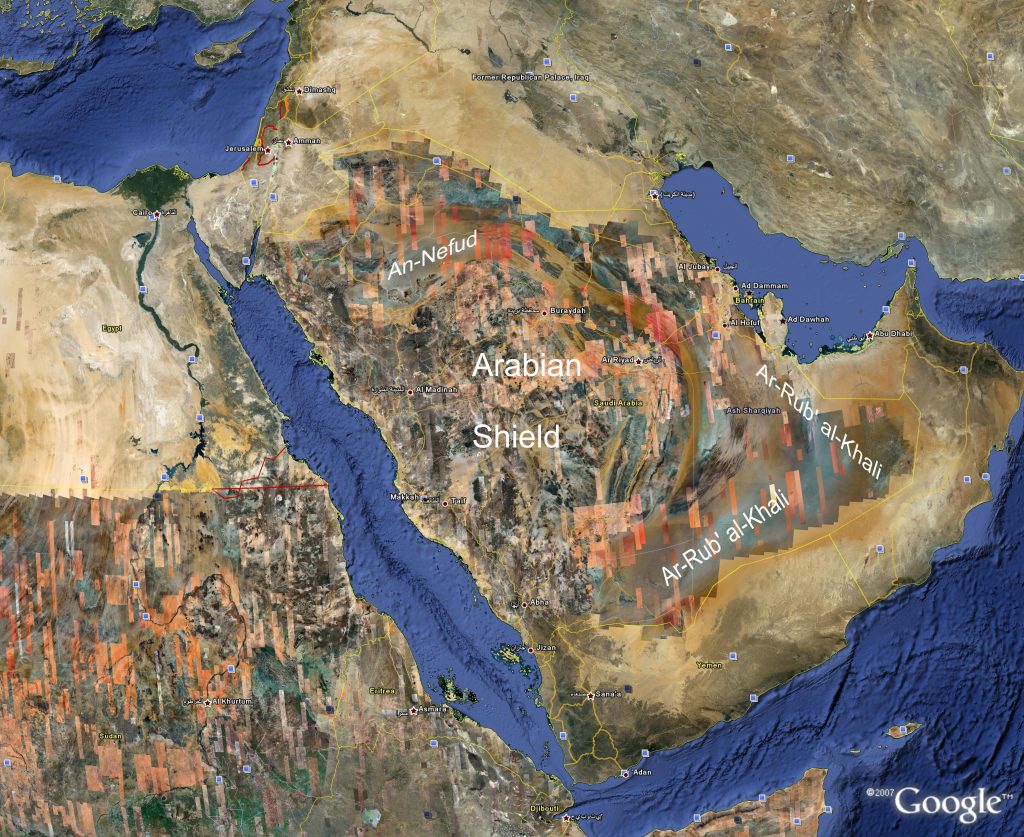
The Arabian Peninsula. The Arabian Shield is an ~850 million year old late-arrival continental craton. It was split off from Egypt, Sudan, and Eritrea on its western side by a rift 35 million years ago; that rift is now called the Red Sea. The Empty Quarter is a platform of Paleozoic sedimentary rock that hosts giant oil deposits like the famous Ghawar Field. It is now covered by sand that has been blown from the north and northwest as the Arabian Shield has weathered away over time.
The size of France, Belgium, and the Netherlands combined, The Empty Quarter is the largest contiguous sand dune desert in the world, an area as dangerous – and logistically more difficult to cross – than Antarctica. If an accident had befallen anyone, no helicopter or fixed-wing aircraft could have ever reached us because of density-altitude problems, and the fact that the ar-Rub’ al-Khali is covered by contiguous sand dunes. A helicopter cannot operate over any significant distance because of the heat-thinned air (density-altitude), not with any real load, in temperatures of 40-61C. A fixed-wing aircraft could never land in sand dunes.
The Empty Quarter is populated by huge 150-km-long ‘Irq (“vein” – after the veins in a man’s arm) dunes, 700 meter-high horned Barchan dunes, wall-like Zibar dunes blocking movement down the Shugs (the corridors between ‘Irq dunes). There are also large areas of lag-gravel plains with Seif (“sword”) dunes marching across them. In the eastern margins there are sabkhas: dry-crusted, lithium-rich brine-mud lakes. We measured temperatures up to 61 degrees C. (142 degrees F.) on the first Zahid Expedition, and encountered humidity down to 2% (20% is considered extremely dry in the southwestern US). Around the edges of the Empty Quarter we encountered 10-cm-long carnivorous jerboas (kangaroo mice), 15-cm-wide camel-spiders, meter-long sand-vipers, and 10-cm-long, translucent scorpions. The central core of the desert, where even al-Murra tribesmen don’t venture, was absolutely lifeless. Here we found thousands of ancient dried lakes on two different levels between the huge ‘Irq dunes, clear evidence of two previous pluvial periods (~17,000 and ~10,000 years ago). We also found elegant flint arrow-heads, and evidence of huge water-buffalo-like bovids (see photos of a skull, of fresh-water molluscs, and arrow-heads below and on the Images page). This ancient Land of 10,000 Lakes had human dwellers, birds, bovids, even hippos.
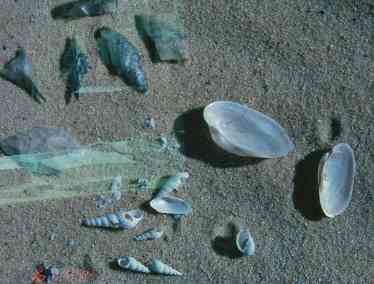
Freshwater mollusks and arrowheads found on the edges of an ancient, ~10,000-year-old lake, southern Empty Quarter. Humans hunted here!
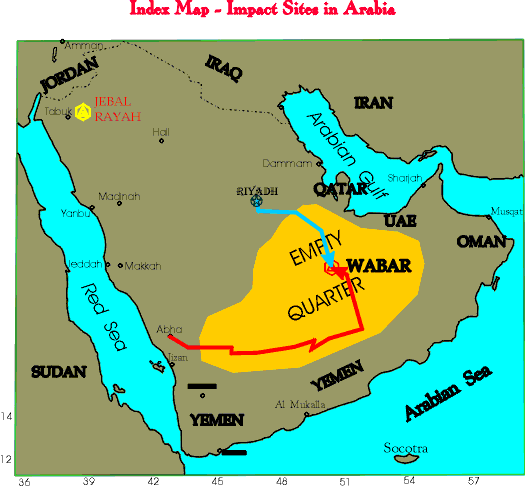
Zahid Expedition routes to the Wabar Asteroid Impact site, showing the outlines of al-Rub’ al-Khali.
Life on the Zahid Expeditions in the hottest desert on Earth
Life for us in the Empty Quarter followed a routine of morning ablutions from a canteen, a light breakfast, then we would pack our Hummer vehicles and move on, typically covering 250 to 500 km before our next camp-site. We brought all our water and all our fuel with us: 700 litres of diesel per Hummer, 100 litres of water per person. The average weight of each Hummer was thus about 11,800 lbs (5.4 metric tons). The temperatures reached 55-61 degrees C (130-142 degrees F) during the day, and some of our vehicle air-conditioners failed from the terrible overload… in those vehicles, moving wind was the only coolant, and we rotated seats because a day in that heat would exhaust everyone. For 10 months out of the year, the winds in the Rub’ Al-Khali pick up around noon local time from the north-northeast and reach a screeching crescendo around sunset; during the February-March Arabian Sea monsoon season, the winds reverse direction and come from the south-southwest. As the sun would set, we would set up tents in the late afternoon sand-storm, some of us wearing swim-goggles to protect our contacts and eyes from the stinging grit. Dinner was almost always mixed with flying sand; you could feel it grinding in your teeth: we jokingly called our dinners sand-burgers, grit-goulash, sand-pudding. Sleeping at night consisted of first securing the tent against scorpions and camel-spiders, which would leave tracks during the night showing that they were constantly searching for a way in. We then slept on top of our sleeping bags – the temperature normally didn’t go below 40 degrees C (100 degrees F) during the night. We had to carefully brush the grit from our eyes before we dared to open them, and burning throats in the extremely dry conditions (down to 2% humidity) forced us to drink from our individually-issued water-jugs at least 5 times every night. We thus followed a complicated routine every 90 minutes all night long: wipe the grit from our eye-lids, sit up, take a drink from our Coleman water-jugs, and “snuff” a handful of water into our nostrils to ease the terrible burning.
How old is the Wabar Impact site?
Earlier, ~1965-era fission-track dating suggested perhaps 6,500 years. However, during initial examination of the site we found delicate splattered-glass filigree that could not have survived very long in the sand-blasting that occurs daily. Moreover, a photo taken in 1965 from the air shows a 15-meter-deep Philby-B crater. During our visits it was nearly filled with sand. USGS experiments elsewhere show that once a crater is filled with sand it will not spontaneously empty. Ultimately, on Philby’s 1933 book there is a report of a huge fireball seen flying over a southern district of Riyadh – heading towards where Wabar is now. About 25 kilometers north along that line from Wabar there is a site called Umm al-Hadida (“mother of the irons”), with asteroid fragments chemically identical to Wabar. Gene Shoemaker and I spent part of a night – while being sand-blasted by the diurnal storms – collecting sand from beneath the impactite rind of the Philby-A crater (below). These were tested for the last time the quartz sand had seen sunlight (called thermoluminescence dating) and were found to be less than 250 years old.
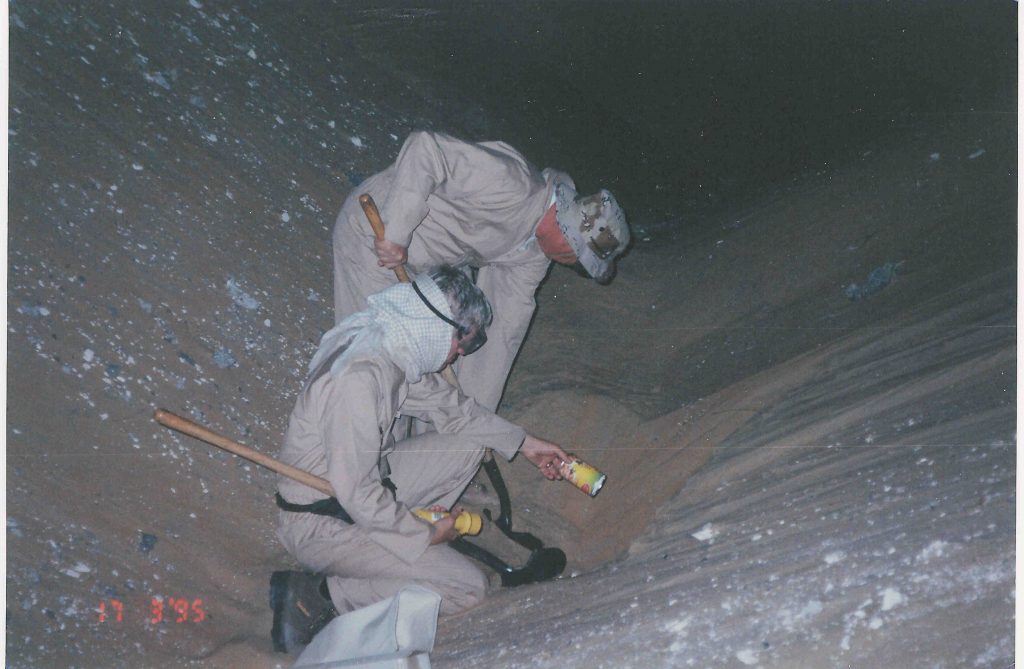
Jeff Wynn and Gene Shoemaker collecting a sample of untouched-by-sunlight sand for a Thermoluminescence date, from beneath the Impactite rind of the Philby-A crater. The sample proved to be less than 250 years (Prescott et al, 2004), providing an outside age. Historical records (Philby, 1933) indicate that the impact took place in the Spring of 1863, with the asteroid passing over Riyadh and arriving from the north-northwest, proven by detailed , week-long geologic mapping.
I Came, I saw, and I Ate…
In the profound, windless silence of the mornings, I walked into the desert with a still and a video-camera to photograph the tracks left in the sand: a mute record of the life-and-death struggles that took place during the night between lizards and snakes, scorpions and camel-spiders, dung-beetles and jerboas. By sunrise, everything that had survived the night was already back under the sands again in a form of high-temperature hibernation. What feeds this ecosystem? Insects blown in from the Gulf and the distant mountains by the diurnal sandstorms. What rare plants we found were either desicated-dead, fossilized remains from the ancient pluvials, or had waxy coats on the needles to protect what moisture they had. We never saw any evidence of plant predation in the core of the ‘Rub al-Khali. Camels and sheep cannot get there and live.
The harsh survival-mode existence we lived under, and working shoulder-to-shoulder, cemented permanent bonds of friendship among us, a comaraderie that crossed cultural and religious barriers. Our fellowship was not quite devoid of humor, the exhaustion at the end of each day notwithstanding.
Beyond the circle of our tents stretched the featureless, rolling dunes of the emptiest place on earth, looking for all the world like the great rollers of the North Atlantic, only motionless, and beige-white.
The Empty Quarter – ar-Rub’ al-Khali is just one name – exerts a strange draw on any who have been near it or spent time in it. One of these is research scientist Jeff Wynn of the US Geological Survey, who lived with his family in Jeddah, Saudi Arabia, for four years. When he was invited by the Zahid Corporation to participate as the expedition scientist, he knew it was a truly rare opportunity – as the Expedition Page list shows.
Jeff Wynn participated in the May 1994, December 1994, and March 1995 Zahid Expeditions, and has published a number of scientific articles on the geologic observations and geophysical measurements made during those trips (see link under Expeditions List). A book describing all three expeditions can be found here:
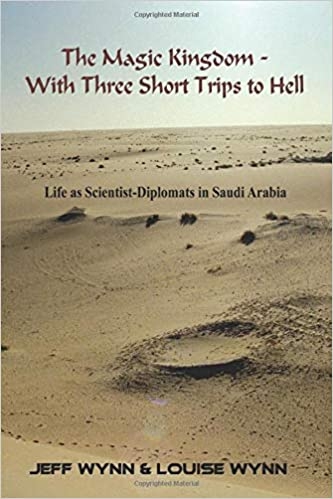
https://www.amazon.com/Magic-Kingdom-Three-scientist-diplomats-Arabia/dp/1980225494/ref=sr_1_2?dchild=1&keywords=Jeff+Wynn&qid=1604447057&s=books&sr=1-2
The Wabar Asteroid Impact site has three known craters (Philby-A, Philby-B, and Wynn… the latter named by Gene Shoemaker for the person who discovered it first), and is similar to the Sedan nuclear test-site in southern Nevada in all respects save one: there is no residual radiation. Yet evidence shows that an explosion comparable to the Hiroshima bomb took place here in 1863. The initial magnetic data-plot, before a Hanning filter was passed through it, looked like a magnetic survey of a junk yard, from all the iron-impregnated sand “glass,” caused by heat that had exceeded 10,000 C during the furious impact mixing process.
Wynn established the initial Empty Quarter Expeditions website in 1996; this site is an outgrowth of that.
NOTE: The photo on the home page, taken by Bill Chasteen, shows Wynn using a Cesium-Vapor Magnetometer to survey the iron-rich ejecta field of the Wabar asteroid impact site, located approximately in the geographic center of the Empty Quarter.